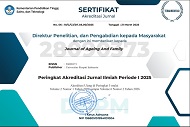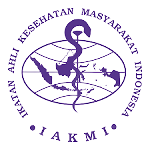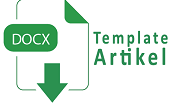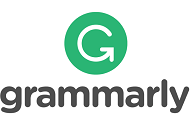Analysis Of The Application Of Electronic Medical Record In RUMKITAL Dr. Mintohardjo With The Measures Of Effectiveness Method
Abstract
Keywords Electronic Medical Record, Measures Of Effectiveness, Rumkital Dr Mintoharjo
Full Text:
PDFReferences
Abdulrahmat, Efektivitas Implementasi, PT Rineka Cipta, Jakarta, 2003.
Al-Azmi, Saadoun Fariz, et al. “User’s attitude to an electronic medical record system and its correlates a multivariate analysis.” Health Information Management Journal Vol 38 No 2 2009. https://doi.org/10.1177/183335830903800205
Brender, Jytte. Handbook of Evaluation Methods for Health Informatics. Elsevier Academic Press Publication, Denmark, 2006.
Budiastuti, Dyah dan Bandur, Agustinus. Validitas dan Reliabilitas Penelitian. Jakarta: Mitra Wacana Media. 2018.
Cahyono Tri, Statistik terapan dan indikator kesehatan, Yogyakarta: Deepublish, 2018
Garret P, Seidman J. “EMR vs EHR – What is the Difference?” Health IT Buzz Healthit.gov, Januari 4, 2011. Accessed March 10,2020. http://www.healthit.gov/buzz-blog/electronic-health-and-medical-records/EMR-vs-ehr-difference/
Glandon, Gerald L., et al. Information Systems for Healthcare Management, Seventh Edition. Health Administration Press, Chicago, 2008.
Gunawan T Sintak, Gilbert Mayer Christanto, “Rekam Medis/Kesehatan Elektronik (RMKE): Integrasi Sistem Kesehatan”
Hatta, Gemala R. Pedoman Manajemen Informasi Kesehatan di Sarana Pelayanan Kesehatan. Penerbit Universitas Indonesia, 2008.
Herlambang, Susatyo, Manajemen Pelayanan Kesehatan Rumah Sakit, Gosyen Publishing, 2016.
Jamal, Aziz et al. “The impact of health information technology on the quality of medical and health care: a systematic review.” Health Information Management Journal Vol 38 No 3 2009.
Kadir, Abdul. Pengenalan Sistem Informasi. Penerbit ANDI Yogyakarta, 2003.
Kasiram, Metodologi Penelitian Kualitatif dan Kuantitatif, 2008.
Kusumadewi, Sri, dkk. Informatika Kesehatan. Graha Ilmu, Yogyakarta, 2009.
Leiner, Florian, et al. Medical Data Management: A Practical Guide. Springer Verlang London Limited, New York, 2003.
McGlynn, Elizabeth A., et al. Health Information Systems: Design Issues and Analytic Applications. RAND, Santa Monica, CA, 2005.
Menteri Kesehatan Republik Indonesia, Tentang Akreditasi Rumah Sakit, Permenkes Nomor 34 tahun 2017
Menteri Kesehatan Republik Indonesia, Tentang Rekam Medis, Permenkes Nomor 269/MENKES/PER/III/2008.
Neill Smith, “A Framework to Model and Measure System Effectiveness” Consultant to DSAD Mission Software P/L.
Pohan.I, Jaminan Mutu Layanan Kesehatan. EGC, Jakarta, 2012
Prasetyo Aster Budi, “ Analisis Kemampuan Kapal Buru Ranjau Kri Kelas Pulau Rengat Guna Mendukung Peperangan Ranjau Modern Dengan Metode Measurement Of Effectiveness Dan Analytical Hierarchy Process,”
Sabarguna, Boy S. Atlas of Managing Information in Hospital. CV. Sagung Seto, Jakarta, 2008.
Sabarguna, Boy S. Buku Pegangan Mahasiswa Manajemen Rumah Sakit. CV. Sagung Seto, Jakarta, 2011.
Shahmoradi, et al. “Determining the most important evaluation indicators of healthcare information systems (HCIS) in Iran.” Health Information Management Journal Vol 36 No 1 2007. https://doi.org/10.1177/183335830703600103
Sondang P. Siagian, Kiat Meningkatkan Produktivitas kerja, Rineka Cipta, Jakarta, 2002.
Sugiharto, Susanto, Bahan Ajar Rekam Medis dan Informasi Kesehatan:: Etika Profesi dan Hukum Kesehatan, Kementerian Kesehatan Republik Indonesia, Jakarta, 2017
Sugiyono, Metode Penelitian Kombinasi, Alfabeta, Bandung, 2015.
Sugiyono, Metode Penelitian Pendidikan, pendekatan kuantitatif, kualitatif dan R & D, Alfabeta, Bandung, 2015.
Sutoto, Standar Nasional Akreditasi Rumah Sakit, Komisi Akreditasi Rumah Sakit, Jakarta, 2017.
Triyanti, Weningsih, Bahan Ajar Rekam Medis dan Informasi Kesehatan: Desain Formulir, Kementerian Kesehatan Republik Indonesia, Jakarta, 2018
Wijaya Made Indra, “Studi Atribut Rekam Medis Elektronik Terhadap Kinerja Rekam Medis Elektronik Di Rumah Sakit Khusus BIMC,”
Wollersheim, Dennis, et al. “Archetype-based electronic health records: a literature review and evaluation of their applicability to health data interoperability and access.” Health Information Management Journal Vol 38 No 2 2009. https://doi.org/10.1177/183335830903800202
DOI: https://doi.org/10.52643/joaf.v2i2.4143
Refbacks
- There are currently no refbacks.
Copyright (c) 2024 Journal of Ageing And Family

This work is licensed under a Creative Commons Attribution 4.0 International License.

This work is licensed under a Creative Commons Attribution-ShareAlike 4.0 International License.














